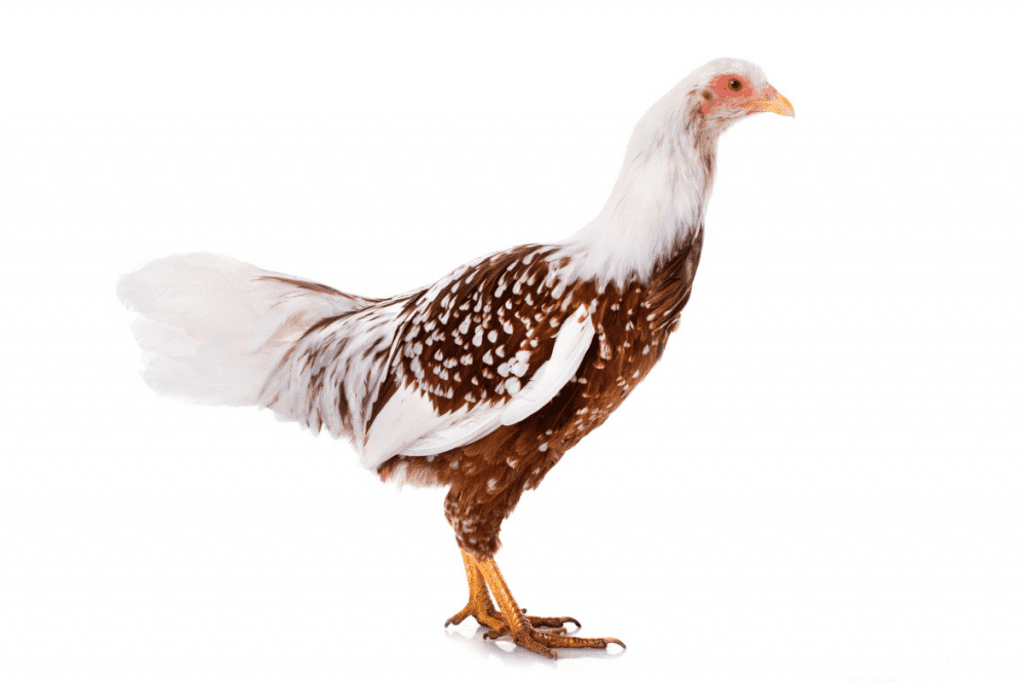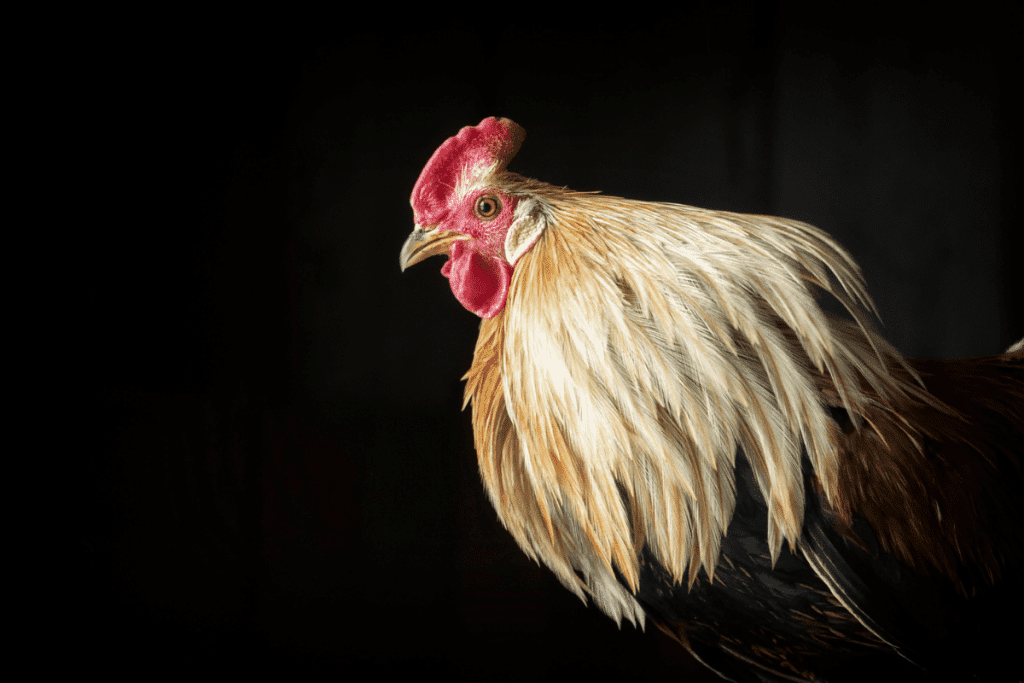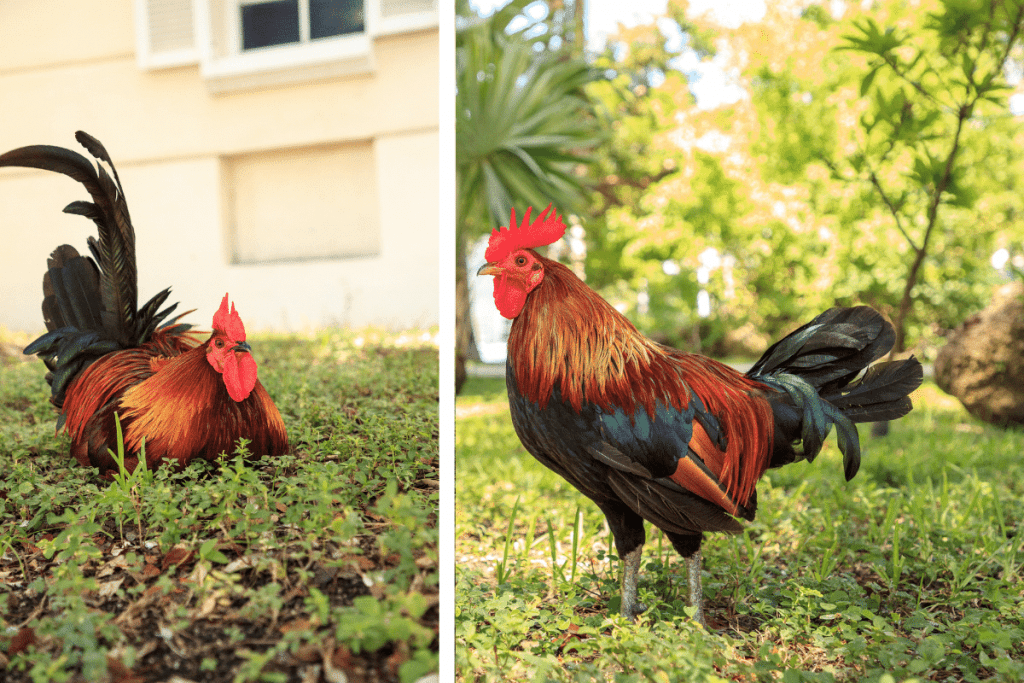Centuries of selective breeding have resulted in around 100 different breeds with exceptional traits, such as brightly-colored plumage, feathers with strange textures, and even different comb shapes!
You’ve likely searched high and low for birds with stunning features if you love having a diverse flock.
One particular trait which has similarly been bred to the extreme is the tail feathers.
There are now several breeds with tail feathers exceeding several feet in length, trailing behind the birds like an elegant dress or robe.
Here are a few of our favorites if you’re interested in learning more about them or even obtaining one of these exceptional chickens for your flock!
Table of Contents
ToggleOnagadori Chicken

Of all the breeds which have been carefully developed to have long, sleek tail feathers, the Onagadori is perhaps the most visually stunning.
These incredible birds have existed in Japan since the 1600s, making them an ancient breed with a long and rich history!
If you’ve ever seen a picture of these rare, pricey birds or perhaps been lucky enough to observe one in person, you likely didn’t even believe what you saw at first!
Their tail feathers almost look like the aftermath of a malfunctioning VHS tape, with black, glossy film spooling chaotically in various directions.
But your eyes don’t deceive you–those beautiful yet almost comically long tail feathers result from many years of selective breeding.
The Onagadori is even considered one of Japan’s Special Natural Treasures!
These long-tailed chickens are raised in a particular area of Shikoku, where they were likely developed via crossbreeding of several other ancient Japanese longtail chicken breeds.
Today, only a handful of expert breeders can produce the birds, as they are difficult to care for and don’t breed very well in captivity.
Because their tail feathers often reach over 20′ feet long, Onagadori chickens must have specially-designed coops and perches to accommodate them.
These long-tailed ornamental chickens currently exist in several color variants, though only three main varieties are currently recognized in Japan: black-breasted white, black-breasted red, and plain white.
European poultry organizations typically recognize five distinct colors.
Aside from its long tail feathers and vibrant colors, the Onagadori’s traits are mundane, with single combs and clean legs being the breed standard.
Interestingly, this Japanese breed was likely involved in developing the similarly long-tailed Phoenix breed, which we’ll cover further down in this list.
Yokohama

Though the Yokohama is a German breed, it was developed by breeding birds brought to Europe from Japan!
It’s existed since 1880 and was named after the port it came from in 1864.
Like the other breeds on this list, the Yokohama is known for its exceptionally long tail feathers and the long saddle feathers on its back.
Today, these beautiful chickens exist in two main color variants in Germany: white and red-saddled.
Things are a little more confusing in the UK, as the name “Yokohama” also refers to the similar-yet-distinct Phoenix breed.
They acknowledge many additional color variants of both birds, like the spangled, blue-red, and silver duckwing varieties.
See more blue chicken breeds in our list at the link.
Though it’s mainly kept as an ornamental/show bird or beloved pet, the Yokohama is a fair egg-layer; adult hens typically produce around 80 to 100 eggs per year, while the bantam variety of the Yokohama produces slightly more (yet also much smaller) eggs.
Yokohama birds are alert and active with a curious, intelligent, and surprisingly friendly temperament.
They’re much quieter than most other chicken breeds, making them a good choice of ornamental bird for chicken keepers living in more urban areas.
Their feathers aren’t nearly as long as those of the Onagadori, but it is still common for them to reach over 5′ feet in length!
However, due to their long plumage, roosters often require taller perches and a bit more room in their coops to feel comfortable.
Their white tail and saddle feathers are prone to becoming dirty and wet easily.
Though they are tall and wide in stature, they are lightweight birds at only around 3 to 5 pounds.
Hens are much lighter and shorter in size than roosters and have much shorter, more upright tail feathers.
Phoenix Roosters

As we touched on earlier, the Phoenix chicken was developed by crossbreeding imported Japanese ornamental birds like the aforementioned Onagadori and Yokohama!
These beautiful birds, particularly the roosters, have sleek, glossy plumage, long, flowing tails, and saddle feathers.
However, the Phoenix’s tail feathers aren’t as long as those of its Onagadori predecessors.
This is likely due to the Onagadori’s recessive gene, which stops it from molting, resulting in its tail feathers constantly growing its entire life.
Still, the Phoenix’s tail feathers are impressive, often growing more than 3′ feet long!
Interestingly, this breed was developed by one of the same people who played a large role in Yokohama’s development, the president of the National German Poultry Association, Hugo du Roi.
Other birds involved in the development of the Phoenix include the Leghorn, Malay, Kruper, and Old English Game breeds.
The breed’s classification in the exhibition scene is confusing, as the Phoenix is commonly lumped in with the Yokohama.
The Poultry Club of Great Britain, for instance, considers Phoenix birds to be Yokohamas and does not recognize the Phoenix as its unique breed.
Other groups separate the two and refer to them as two distinct breeds.
Today, these birds are mainly popular for pets and ornamental purposes, as they are far from ideal egg or meat producers.
They are one of the most docile and gentle breeds on this list, making them excellent, friendly, and easily handleable pets.
Additionally, they are surprisingly hardy for an ornamental breed.
Their beautiful feathers don’t require nearly as much maintenance as other breeds of chicken with longer tail feathers like the Onagadori and, to a lesser extent, the Yokohama.
Sumatra

This handsome breed is native to Indonesia and is known for its long tail feathers and its glossy, jet-black plumage, skin, combs, and wattles.
Though it exists in a small array of breed colors, classic black is the most popular and representative color type of the breed.
Black Sumatra feathers have a shimmering, iridescent greenish sheen, particularly the roosters’ tail and saddle feathers.
The Sumatra’s tail feathers aren’t as long as those of the Onagadori or Yokohama, but they’re still incredibly impressive!
Additionally, their tails are more upright than those Japanese breeds’ long, flowing feathers.
Native to the island of Sumatra in Indonesia, this breed has existed since the 1800s.
The first Sumatras imported to the US and Europe was mainly used for cockfighting, but they quickly became well-known ornamental birds in the exhibition scene.
In more recent years, they’ve become popular pets amongst hobby farmers looking for a unique-looking breed to add to their flock.
Though the Sumatra chicken has likely been around since the early 1800s, it wasn’t added to America’s Standard of Perfection until 1883.
They are tall, substantial birds but surprisingly petite, with body weights ranging from 4 to 5 pounds.
Unfortunately, Sumatra isn’t a particularly useful breed in egg or meat production.
Sumatran hens produce around 80 to 100 eggs per year, which is a fair amount for an ornamental breed but pales compared to traditional egg-laying breeds who lay upwards of 200 to 300 eggs annually.
Since they are so lightweight, they aren’t very practical for meat, either.
Still, as an ornamental exhibition breed, the Sumatra is a stunning bird and an entertaining pet.
They are hardy, active, athletic birds, and they are surprisingly skilled fliers and can jump far and high.
Though they are more skittish and take longer to warm up to their owners than most other breeds, their nervousness fades in time with careful handling and socialization.
Cubalaya

The Cubalaya is the only Cuban breed on this list. It was developed via the careful crossbreeding of Sumatra and Malay chickens imported from the Philippines in the 1800s.
These handsome birds were originally bred for their uniquely curved beaks and long tail feathers, which are the main traits they are still prized for today.
Compared to the other chicken breeds on this list, the Cubalaya is perhaps the most friendly and docile.
Both roosters and hens of the breed are calm, curious, and intelligent birds who tolerate handling quite well.
In terms of egg production, the hens are also much better layers than the other long-tailed breeds listed here, though their eggs are small due to the breed’s diminutive size.
According to breed standards, Cubalaya chickens exist in three main color variants: black, white, and black-breasted red.
However, several other colors have been bred and developed over the years.
They exist in both standard and bantam sizes with significant differences in body weight; standard Cubalayas weigh around 4 to 5 pounds, while birds of the bantam variety are much smaller at only about 1.5 to 2 pounds.
Another useful trait of the Cubalaya is its exceptional heat tolerance.
Since it was originally developed in a very hot, humid region, it has retained its ability to thrive in warmer climates.
The roosters’ tail feathers are among the shortest on this list, but it is still common to grow to lengths exceeding 24″ inches.
The hens have much shorter, similarly downward-pointing tail feathers.
Check out these other great-looking chicken breeds for showing.
Chickens In Japan
Japan is known for its love of chickens and unique chicken breeds.
Besides the ones we mentioned above, here are a few you may want to check out:
- Ukokkei Chicken
- Kawachi-Yakko Chicken
- Koeyoshi Chicken
- Uzura Chabo Chickens
- Jitokko Chicken
- Bantam Chambo Chickens
- Tosa-no-Onagadori Chicken
- Shamo Chickens
How useful was this post?
Click on a star to rate it!
We are sorry that this post was not useful for you!
Let us improve this post!
Tell us how we can improve this post?
